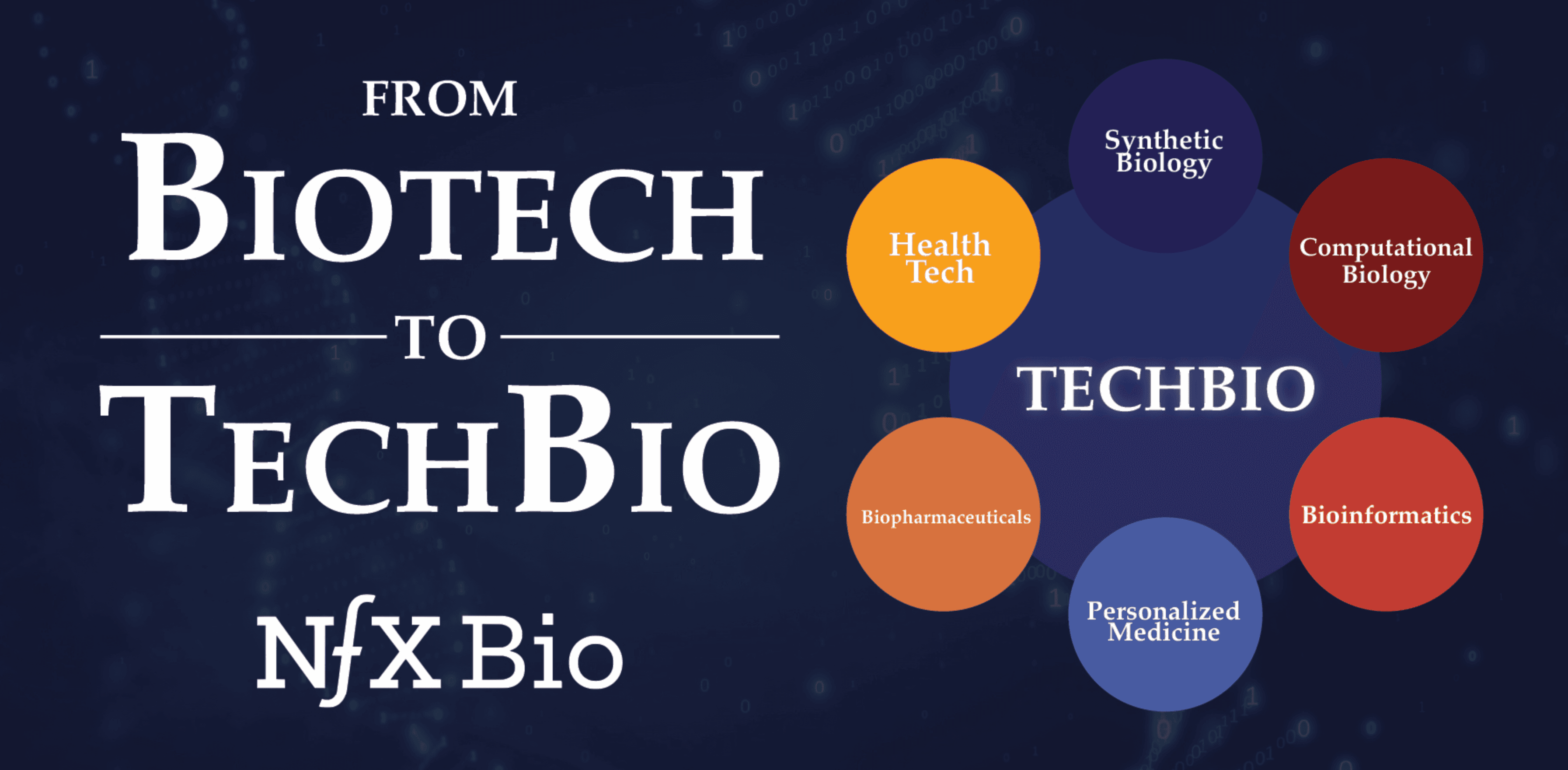

The term “Biotechnology” was coined in 1919. Today we see a shift to technology-first biotechnology companies – what we’ve been calling TechBio for the past 10 years.
Biology is the most advanced technology on earth. Imagine a cell phone that can grow, reproduce, and fix itself. That’s what our cells know how to do. It’s what everything from a single cell of yeast or bacteria, to a great redwood tree knows how to do.
And now thanks to incredible enabling technologies, we are learning how to harness the awesome power of biology to do the most important things on earth: to heal, to feed and to provide for ourselves and for our planet.
Why Now? What’s Driving TechBio?
I’ve seen the emergence of TechBio first as a scientist at Stanford, then as a Founder at Genome Compiler, a Founder and investor at Tech.Bio, and now as an investor and GP at NFX Bio. There are three main tech-driven trends that are enabling and pushing this new industry forward:
- Biology is getting digitized. Technologies like DNA synthesis, sequencing, and sensors are cheap and getting cheaper, enabling us to turn analog biology into digital data and back to analog synthetic DNA/biology.
- Computation and machine learning have advanced. Now that biology is digital, we can use advancements in AI and machine learning to make sense of the huge amount of digital biology datasets.
- We are moving from scientists pipetting in a lab, to high throughput automation at scale. Labor that once took months or even years can be done rapidly, remotely, and most importantly, in a reproducible manner. It’s speeding up the scientific method like we’ve never seen before.
These trends accelerate design-build-test-learn iteration cycles. These unlock more scientific discoveries, allow companies to create products faster, and provide robust and diverse pipelines for companies to develop, co-develop, and partner to work on multiple verticals and products.
TechBio’s Defensible Magic
At NFX, we look for TechBio platform companies with multiple shots on goal, and multiple ways to get to market.
An example that has become a household name due to their pivotal role in the Covid-19 pandemic is Moderna, spun out of Bob Langer’s lab at MIT. Originally intended to work on oncology and HIV, Moderna was uniquely suited to quickly pivot when the pandemic hit and produce an mRNA vaccine. Moderna never described itself as a vaccine company, or even a drug company, but as a leading “mRNA technology platform.” They received the Covid-19 sequence the same day it was sequenced in China and two days later had a working prototype that they could start testing. Digital to analog to digital again. That’s the power of TechBio platform companies.
Here are a few more companies that get it:
Example 1: Mammoth Biosciences, CRISPR discovery platform.
Mammoth Biosciences was initially built around novel Cas systems that could be used broadly for diagnostics (both DNA and RNA detection). Later on, even more new Cas proteins were found by members of Jennifer Doudna’s lab and the Mammoth team that would allow for precise, and easier-to-deliver genome editing. Mammoth could have decided to double down on one side or the other, but instead they decided to do both. Now, Mammoth is a billion-dollar biological toolbox that has signed major deals with both Vertex and Bayer on the therapeutic side (with a huge mission of potentially curing all genetic diseases) and with AstraZeneca and the US government on the diagnostic side.
Mammoth’s platform discovers new CRISPR proteins, characterizes them, and figures out what to use them for. It can find the right tool to solve a specific biological problem from diagnostics to therapeutics. And it does so in a repeatable, scalable way – where the data it produces feeds and guides their downstream experiments.
Example 2: Edity Biosciences, cell delivery platform
Recently, we invested in a company built around the idea of modifying immune cells to turn them into a delivery mechanism. The idea was to hijack one of the cell’s naturally evolved mechanisms to deliver something new. It could be a CRISPR system, yamanaka factors for partial cellular reprogramming, enzymes… There are endless possibilities.
This is a very TechBio platform. You take something from nature, and apply a modern engineering mindset to it – going from serendipitous discovery to very intentional engineering and harnessing of biology. And the affordability of DNA is what enables the engine under the hood. Ten to twenty years ago, you could have had the same brilliant idea but the cost of making these constructs would have been prohibitive.
Example 3: Mana.bio, RNA delivery platform
For some platform companies, the way to be defensible is to produce new data that forms a loop. Companies like Mana have done this especially well. Their data acquisition team can grab data from open sources, combine it with in house data, and use that to generate new, testable protocols. Then, the cycle repeats, more powerful than the last run since it builds on itself.
That’s powerful because it allows us to learn from mistakes. You don’t get to read about failed experiments in scientific journals, but with a platform that uses that data, you can.
What Business Models Work In TechBio?
We’re bullish on platforms because they are able to operate as horizontal and vertical businesses.
What I like about TechBio companies is that they can generate revenues early on. They have these unique capabilities that other companies can pay for, or collaborate with – similar to a CRO model. They might collect revenues from milestone payments, royalties, or subscriptions, all options that aren’t often available if you’re betting it all on only one asset.
But platforms can also work horizontally. Now, we’re seeing TechBio companies that can actually deliver value in the form of multiple products – even consumer products.
We like to see companies that are a combination of a vertical platform, and horizontal product approach.
Who is a TechBio Founder?
Scientists have not traditionally been empowered to run companies. They have historically been replaced by people with business experience, while the scientist gets diluted like crazy. Instead, we believe the best founders are Scientist-Founders. We help scientists learn to be Founders and have found it works far better than the other way around.
Look at Mammoth Biosciences, co-founded by then-28-year-old CEO Trevor Martin, Janice Chen, and Lucas Harrington, with Nobel Prize winner and CRISPR pioneer Jennifer Doudna, spun out of Jennifer’s lab at UC Berkeley.
This kind of opportunity to make a large scale impact is animating to Ph.D.s who don’t want their work limited to academia. They want to see their science out in the real world – helping people and making an impact.
Scientist-Founders want to rip a hole in the universe and create something. They’re motivated to say: I can just go do this myself.
The Time For Solving Problems At Scale Is Now
At NFX, we are one of the few seed-stage investors exclusively focused on TechBio. There are even fewer of us who have been through the entire arc from grad school, to starting a TechBio company, to merging with an industry leader that scaled into the billions.
While there aren’t many now, I have no doubt there will be more investors like us in the next five years. Every company that succeeds is a proof point for the next. The rest of the world will benefit when there are more TechBio founders and investors in the space.
Like you, we understand the time for solving the world’s problems – at scale – is now. Science has never been more central to shaping a better future. The next significant phase of human progress is going to be led by these Scientist-Founders who build TechBio companies capable of unlocking that future.
As Founders ourselves, we respect your time. That’s why we built BriefLink, a new software tool that minimizes the upfront time of getting the VC meeting. Simply tell us about your company in 9 easy questions, and you’ll hear from us if it’s a fit.
